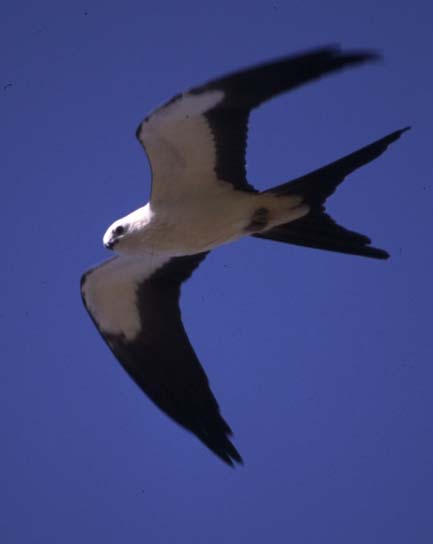|
| 질의: Small white | 결과: 988번째/2237 | |
Swallow-tailed Kite (Elanoides forficatus) - Wiki
| 제목: | Swallow-tailed Kite (Elanoides forficatus) - Wiki
| |

| 해상도: 433x544
파일크기: 11718 Bytes
등록시간: 2007:10:22 11:14:06
|
Swallow-tailed Kite
From Wikipedia, the free encyclopedia
[Photo] Swallow-tailed Kite (Elanoides forficatus) from USFWS. Public Domain.
The Swallow-tailed Kite (Elanoides forficatus) is an elanid kite which breeds from the southeastern United States to eastern Peru and northern Argentina. Most North and Central American breeders winter in South America. It was formerly named Falco forficatus.
Physical description
The species is 55 to 65 cm in length, with a wingspan of approximately 1.3 m. Male and female individuals appear similar. The body is a contrasting deep black and white. The flight feathers, tail, feet, bill are all black. Another characteristic is the forked tail, hence the name swallow-tailed.
Young Swallow-tailed Kites are duller in color than the adults, and the tail is not as deeply forked.
Habitat and behavior
Swallow-tailed Kites inhabit mostly woodland and forested wetlands near nesting locations. Nests are built in trees, usually near water. Both male and female participate in building the nest.
Sometime a high-pitched chirp is emitted; though the birds mostly remain silent.
Feeding, drinking, mating
The Swallow-tailed Kite feeds on small reptiles and insects, and drinks by skimming the surface and collecting water in its bill.
Mating occurs from March to May, with the female laying 2 to 4 eggs. Incubation lasts 28 days, and 36 to 42 days to fledge.
Conservation in the United States
Swallow-tailed Kites are not listed as endangered or threatened by the federal government in the United States. They are listed as endangered by the state of South Carolina and as threatened by the state of Texas. They are listed as "rare" by the state of Georgia. Destruction of habitats is chiefly responsible for the decline in numbers. A key conservation area is the Lower Suwannee National Wildlife Refuge in Florida.
http://en.wikipedia.org/wiki/Swallow-tailed_Kite
| The text in this page is based on the copyrighted Wikipedia article shown in above URL. It is used under the GNU Free Documentation License. You may redistribute it, verbatim or modified, providing that you comply with the terms of the GFDL. |
|
^o^
동물그림창고 똑똑전화 누리집
^o^
|
|